Monday, October 31, 2005
Hirvet lisääntyvät Hirvasjoella - More observations of mooses at Hirvas river valley
Klo 12:45 huomasin Hirvasjoen eteläpuolella uroshirven, 4-piikkisen, ja vähän ajan päästä naaraan sekä toisen uroksen joka oli 6-piikkinen. Se seuraili naarasta, väliin nuuhkien ilmaa. Nelipiikkinen oli kauempana. Äkkiä se ilman näkyvää syytä lähti vauhdilla juoksuun ja hävisi. Toiset hirvet jäivät paikoilleen. Näyttää siltä, että niiden kiima-aika on vielä kesken.
Hirvasjokilaaksossa näkyi hirvenjälkiä ja kiimakuoppia runsaasti eri puolilla. TH
At 12:45 I saw a male moose at the east side of the Hirvasjoki river - with horns of
4 tines, and then a female and another male with 6 tines. The 6-tiny followed the female smelling the air, the other male was farther away. Suddenly the 4-tiny escaped without visual reason. The other mooses stayed. It seems that the mating time still goes on. Many tracks, and pits of rut everywhere, were seen in the Hirvas river valley. TH.
31.10.05 на восточной стороне реки Хирвасйоки я видел самца лося - рогац с четереымя зубцами, и потом самку и рогаца с 6 зубцами в 12.45 ч. Самец 6-зубц. следовал за самкой иногда нюхая воздух. Самец меньше был дальше. Вдруг без видимой причины он убегал и изчес. Другие остались на месте. Кажеться, что время течки еще продолжается. Везде на долине р. Хирвасйоки вбыло видно следы и ямки течки лосей.
Hirvasjokilaaksossa näkyi hirvenjälkiä ja kiimakuoppia runsaasti eri puolilla. TH
At 12:45 I saw a male moose at the east side of the Hirvasjoki river - with horns of
4 tines, and then a female and another male with 6 tines. The 6-tiny followed the female smelling the air, the other male was farther away. Suddenly the 4-tiny escaped without visual reason. The other mooses stayed. It seems that the mating time still goes on. Many tracks, and pits of rut everywhere, were seen in the Hirvas river valley. TH.
31.10.05 на восточной стороне реки Хирвасйоки я видел самца лося - рогац с четереымя зубцами, и потом самку и рогаца с 6 зубцами в 12.45 ч. Самец 6-зубц. следовал за самкой иногда нюхая воздух. Самец меньше был дальше. Вдруг без видимой причины он убегал и изчес. Другие остались на месте. Кажеться, что время течки еще продолжается. Везде на долине р. Хирвасйоки вбыло видно следы и ямки течки лосей.
Labels: hirvi
Sunday, October 30, 2005
Viherpeippo Ainikuusikossa - Greenfinch in Ainikuusikko
Viherpeipon kutsuääni kuului Ainikuusikossa, Värriön luonnonpuiston pohjoispuolella. TH.
Voice of European greenfinch (Carduelis chloris) was heard in Ainikuusikko (old Norway spruce forest, north of Varrio nature reserve) TH.
Voice of European greenfinch (Carduelis chloris) was heard in Ainikuusikko (old Norway spruce forest, north of Varrio nature reserve) TH.
Riekon kaivuu suojalumessa - Willow ptarmingan's traces in melting snow
 Kun suojasää pudottaa lumen pinnan riekot pääsevät vielä syömään syksyn marjoja, kuten kuvan mustikkaa.
Kun suojasää pudottaa lumen pinnan riekot pääsevät vielä syömään syksyn marjoja, kuten kuvan mustikkaa.When the late autumn snow starts to melt for a while, willow ptarmigans (Lagopus lagopus) have still a chance to dig and browse the autumn berries, like Bilberry (Vaccinium myrtillus) in the photo.
Saturday, October 29, 2005
Pirunkuru suojalumessa - Devil´s creek in melting snow
 Ennenkuin sydäntalvi tulee Värriön luonnonpuistoon, pakkanen ja suojasää vuorottelevat. Kuvassa sulavaa lokakuun lunta Pirunkurussa.
Ennenkuin sydäntalvi tulee Värriön luonnonpuistoon, pakkanen ja suojasää vuorottelevat. Kuvassa sulavaa lokakuun lunta Pirunkurussa.In the late autumn, until the deep winter arrives in Varrio Nature Reserve, periods of frost and melting snow alternate. In the photo the Devil's creek in October.
Friday, October 28, 2005
Metsänrajamänty Värriötunturissa - Timber line pine in Varrio
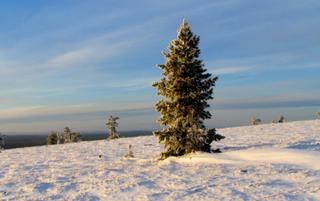 Männyt valtaavat vähitellen Värriötuntureita; metsänraja nousee ilmaston muutoksen myötä. Kuvassa terve, aikaisempien talvien tykkylumista selvinnyt, verraten hyväkasvuinen mänty varsinaisen puurajan yläpuolella, Värriö I:n lounaisrinteessä.
Männyt valtaavat vähitellen Värriötuntureita; metsänraja nousee ilmaston muutoksen myötä. Kuvassa terve, aikaisempien talvien tykkylumista selvinnyt, verraten hyväkasvuinen mänty varsinaisen puurajan yläpuolella, Värriö I:n lounaisrinteessä.Scots pines are are conquering the fell tops, as an apparent result of climate change. The photo is from south-western slope of Varrio I. The seemingly healthy and relatively vigorous Scots pine is growing above the timber line proper, in the zone of heavy frost snow burden.
Thursday, October 27, 2005
Mattimyöhäiset punakyljet - Late Redwings
Klo 12:25 havaitsin kaksi punakylkirastasta (Turdus iliacus) Nuorttiaavan
etelälaidalla koivikon reunassa. Toinen oli hyvin pörhöllään noin 16 asteen pakkasessa. Ainakin toinen oli paikalla vielä klo 17. Lunta oli noin 15 senttiä. Tämä on myöhäisin havainto näiltä seuduin, edellinen ennätys on 22.10.1980. Muut muuttolinnut näyttävät jo lähteneen. TH
At 12.25 o'clock I saw two Redwings (Turdus iliacus) in birches at the southern side of Nuorttiaapa mire. One bird was rumpled because of the frosty weather of about -16 degrees. The snow depth was about 15 cm. At least one bird was there still at 17 o'clock. This is the latest observation of this area, the earlier record was on 22 October 1980. Other migratory birds seem to have already gone away. TH
в 12.25 ч. я видел два белобровика (Turdus iliacus) на южной окраине болота Нуорттиаапа на березах. Один из них был на месте еще в 17. ч. Тогда был мороз 16 градусов и ок. 15 см снега. Это самое поздное наблюдение этого региона, предыдущий рекорд был сделан в 22.10.1980. TH
etelälaidalla koivikon reunassa. Toinen oli hyvin pörhöllään noin 16 asteen pakkasessa. Ainakin toinen oli paikalla vielä klo 17. Lunta oli noin 15 senttiä. Tämä on myöhäisin havainto näiltä seuduin, edellinen ennätys on 22.10.1980. Muut muuttolinnut näyttävät jo lähteneen. TH
At 12.25 o'clock I saw two Redwings (Turdus iliacus) in birches at the southern side of Nuorttiaapa mire. One bird was rumpled because of the frosty weather of about -16 degrees. The snow depth was about 15 cm. At least one bird was there still at 17 o'clock. This is the latest observation of this area, the earlier record was on 22 October 1980. Other migratory birds seem to have already gone away. TH
в 12.25 ч. я видел два белобровика (Turdus iliacus) на южной окраине болота Нуорттиаапа на березах. Один из них был на месте еще в 17. ч. Тогда был мороз 16 градусов и ок. 15 см снега. Это самое поздное наблюдение этого региона, предыдущий рекорд был сделан в 22.10.1980. TH
Wednesday, October 26, 2005
Ensi latu ensilumessa - First ski track in first snow
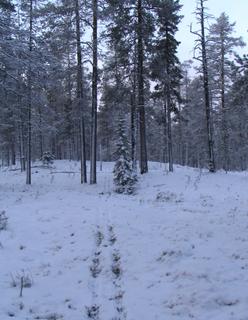 Kun lunta on noin 10 cm, matkanteko suksilla alkaa käyttää Värriötunturin outamassa joutuisammin kuin kulkeminen jalan. Pakkaspäivän kuva Hirvasjoen Petäjärinteeltä.
Kun lunta on noin 10 cm, matkanteko suksilla alkaa käyttää Värriötunturin outamassa joutuisammin kuin kulkeminen jalan. Pakkaspäivän kuva Hirvasjoen Petäjärinteeltä.Already when the snow depth is about 10 cm, skiing in Varrio open type forests is easier than walking from one site to another. Frost day photo from Scots pine forest at Hirvas river.
Tuesday, October 25, 2005
Hirvasjoen porokämppä - Reindeer herders´ cabin in Hirvas river
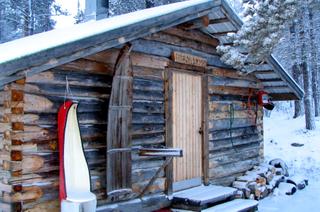 Eteläkaakkoon Värriön tutkimusasemalta, noin kolmen kilometrin päässä sijaitsee Hirvasjoen porokämppä. Kämpän seinustalla on kaksi ahkiota, uudempi lasikuituinen ja vanhempi puinen. Ahkioita kutsutaan paikallisessa puheessa myös vetureiksi.
Eteläkaakkoon Värriön tutkimusasemalta, noin kolmen kilometrin päässä sijaitsee Hirvasjoen porokämppä. Kämpän seinustalla on kaksi ahkiota, uudempi lasikuituinen ja vanhempi puinen. Ahkioita kutsutaan paikallisessa puheessa myös vetureiksi.South-east of Varrio research station, about three kilometers away, the skier finds a cabin that the reindeer herders use for their camping. On the front wall of the cabin there are two traditional sledges, one more modern type, made of glass fibre and the other of older design, made of wood. The sledges are used in winter time by skiers, to haul foodstuff and camping equipment to the wilderness.
Monday, October 24, 2005
Koppelot nousevat mäntyihin - Female capercaillie in Scots pine
 Lumen tultua metsot alkavat totuttautua ainoaan talviseen ravintoonsa, männyn neulasiin. Kuvan koppelo Kotovaaran eteläpuolen männikössä.
Lumen tultua metsot alkavat totuttautua ainoaan talviseen ravintoonsa, männyn neulasiin. Kuvan koppelo Kotovaaran eteläpuolen männikössä.At the first snow the capercaillies start to get acquainted with their only mid winter feed, the Scots pine needles. This female capercaillie was feeding at the southern foothill of Kotovaara
Sunday, October 23, 2005
Metsonjälki Rakitsassa - Capercaillie footprint on Rakitsa hill
 Värriön metsoseurannasta suuri osa on tehty Rakitsan vaarassa. Metsoja seurataan sekä radiopantojen että jälkien perusteella.
Värriön metsoseurannasta suuri osa on tehty Rakitsan vaarassa. Metsoja seurataan sekä radiopantojen että jälkien perusteella.A great deal of Varrio's capercaillie (Tetrao urogallus) monitoring is done on Rakitsa hill. The bird movements are monitored based on radiotracking and on footprints.
Saturday, October 22, 2005
Kuntasjoki jäätyy - Kuntas river is getting ice
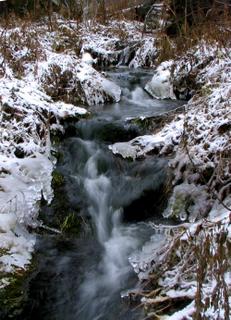 Värriö I:n juurelta itään virtaava Kuntasjoki, rehevä kuru, jäätyy ensilumen myötä.
Värriö I:n juurelta itään virtaava Kuntasjoki, rehevä kuru, jäätyy ensilumen myötä.Kuntasjoki (Kuntas brook) that flows eastwards from Varrio I, gets frozen at the same time as first snow comes.
Friday, October 21, 2005
Pulkkatunturi ensilumessa - Pulkkatunturi fell in first sknow
 Pulkkatunturin selänne on on Värriötuntureiden selänteen itäpuolella. Selänteiden välissä on Hirvasjoen vanhojen mäntymetsien laakso, jossa pääosa tehdään pääosa Värriön metsotutkimuksia. Kuva Kotovaarasta kaakkoon.
Pulkkatunturin selänne on on Värriötuntureiden selänteen itäpuolella. Selänteiden välissä on Hirvasjoen vanhojen mäntymetsien laakso, jossa pääosa tehdään pääosa Värriön metsotutkimuksia. Kuva Kotovaarasta kaakkoon.The eastern Pulkkatunturi is part of a chain of fells, parallel to chain of Varrio fells. The valley of Hirvas river is between the two chains of fells. The valley growing old Scots pine forests, that are home to capercaillies. Monitoring of annual movements of capercaillies is part of Varrio bird research.
Thursday, October 20, 2005
Kukkiko Lapissa kaikki nopeammin, pihlaja - Did Sorbus aucuparia flower earlier?

Pihlajan kukintaa on seurattu Värriössä vuodesta 1992. Se on aikaistunut 13 vuodessa kahdeksalla päivällä. Vuonna 2006 pihljan kukinta alkaa ennusteen mukaan 28. kesäkuuta.
The onset of flowering with Rowan (Sorbus aucuparia) has been followed in Varrio since 1992. In 13 years the onset has become earlier, on average by 8 days. In 2006 the predict onset of flowering takes place on 28 June.
Wednesday, October 19, 2005
Ensilumi Nuorttitunturissa - First snow in Nuortti fell
 Keskiviikkona 19. lokakuuta Värriön luonnonpuistossa satoi varsinaisen vuoden 2005 ensilumen, joka todennäköisesti jää pysyväksi. Kuvassa Nuorttitunturi Kotovaarasta.
Keskiviikkona 19. lokakuuta Värriön luonnonpuistossa satoi varsinaisen vuoden 2005 ensilumen, joka todennäköisesti jää pysyväksi. Kuvassa Nuorttitunturi Kotovaarasta.On Wednesday 19 October the proper first snow proper was received in Varrio nature reserve. According to the prevailing weather forecast the snow apparently stays on the ground. In the photo Nuortti fell from Kotovaara hill (the hill of Smear station).
Tuesday, October 18, 2005
Kultatähkät pajurukassa - Golden buds to frozen willows
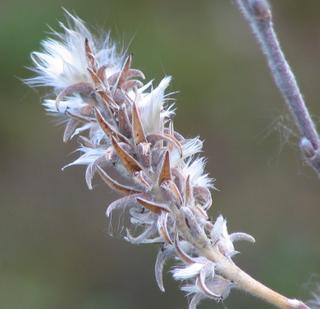
Kuin tunturilla puro hiljaa helää,
ja luopi kultatähkät pajurukkaan,
niin sinäkin, sä Laulu,
saatat kukkaan sen ihmismielen,
jossa kaiho elää
(Yrjö Kilpinen: Laululle, Op. 52, No 3).
Inarilaissyntyisen runoilija V. E. Törmänen lienee tarkoittanut (1925) Yrjö Kilpisen sittemmin säveltämässä tunnetussa runossaan tunturipajua (Salix glauca). Se kukkii vasta kesäkuussa, lehtien jo puhjettua. Kultatähkät valmistuvat syksyllä. Kuva Värriöojan varresta Värriötunturin (Värriö I) luoteispuolelta.
As from the fells the brook so gently streameth,
And yields new golden buds to frozen willows
so too dost Thou, O My Song
bring to blossom the hopes of man
wherever longing dwells.
(Yrjo Kilpinen: To Song, Op 52, No3)
Finnish poet V. E. Tormanen wrote in 1925 a well-known poem "To Song" that was later composed by Yrjo Kilpinen. The willow species in question was apparently Salix glauca. It flowers in June. The buds that thye poem describes (more correctly spikes or ears) mature in late autumn and stay in the stems to the winter. This specimen grows at the Varrio brook, north-west of Varrio fells.
Monday, October 17, 2005
Kukkiko Lapissa kaikki nopeammin: metsätähti - Did Chickweed wintergreen flower earlier?
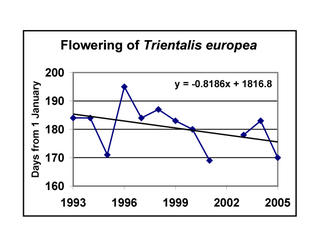
Metsätähden (Trientalis europea) kukinnan alkua on seurattu Värriössä vuodesta 1993. Kahdessatoista vuodessa kukinnan alku on aikaistunut keskimäärin 10 päivällä. Vuosivaihtelu on suuri, eikä ilmiöllä ole (vielä) tilastotieteellistä merkitsevyyttä. - Vuonna 2006 metsätähden kukinnan voi ennustaa alkavan 24. kesäkuuta.
The onset of flowering with Chickweed wintergreen (Trientalis europea) has been followed in Varrio research station since 1993. In twelve years the onset has become earlier by 10 days. The variation around the trend line is considerable and the phenomenon does not (yet) have statistical significance. - The predicted date for 2006 is 24 June.
Sunday, October 16, 2005
Aurinko laskee Puolivälinjängän taakse - Sunset behind Puolivalinjanka

Lokakuun puolivälissä Värriön päivät lyhenevät nopeasti. Aurinko laskee länteen, Puolivälinjängän pitkospuiden taakse.
In the middle of October the Varrio days become quickly shorter and shorter. The sun sets to west, behind the track in Puolivalinjanka aapa mire.
Saturday, October 15, 2005
Poroaita Kynsivaarassa - Reindeer fence in Kynsivaara
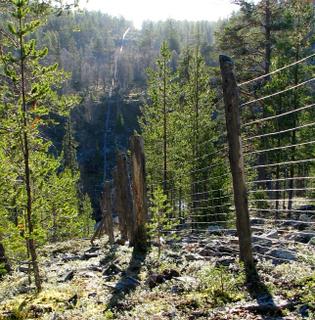 Sallan ja Savukosken kunnanrajalla kulkee poroaita, joka erottaa Sallan pohjoisen paliskunnan (vasemmalla) ja Sompion paliskunnan poroelot. Kuva Kynsivaarasta etelään.
Sallan ja Savukosken kunnanrajalla kulkee poroaita, joka erottaa Sallan pohjoisen paliskunnan (vasemmalla) ja Sompion paliskunnan poroelot. Kuva Kynsivaarasta etelään.A continuous reindeer fence traverses Varrio nature reserve along the municipality border between Salla (left) and Savukoski. Photo south of Kynsivaara hill.
Pakkasrapautuminen murentaa tuntureita - Cold weathering breaks fells
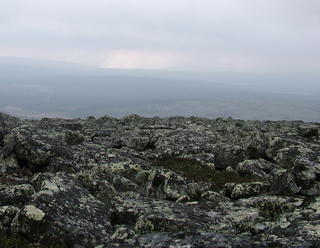
Sauoivan (615 m) pyöreä laki on kokonaan lohduttoman kivikon eli rakan peitossa. Mannerjäätikkö pyyhki huipun puhtaaksi hienoaineksista ja jätti jäljelle vain paljasta kalliota ja suurempia lohkareita. Viimeisen 10 000 vuoden aikana Pohjolan ankara ilmasto on tehnyt tehtävänsä: syksyisin tunturissa vihmoo vettä, joka valuu kallion ja kivien halkeamiin, vesi jäätyessään kiilaa halkeamia leveämmiksi ja irrottaa kivenkappaleita toisistaan. Jyrkässä rinteessä irronneet kivenlohkareet ovat romahtaneet mikä mitenkin päin hankaloittamaan vaeltajan kulkua.
Rocky and difficult ground covers Sauoiva fell (615 m). Over 10 000 years ago ice sheet cleared of smaller particles from Sauoiva. During thousands of years cold weathering broke stones: water in cracks freezes and push apart stones. Steep slopes of Sauoiva are not comfortable terrain to hike. (PM)
photo: Ella-Maria Kyrö
Friday, October 14, 2005
Tervasroso Kynsivaarassa - Resin top of pine in Kynsivaara
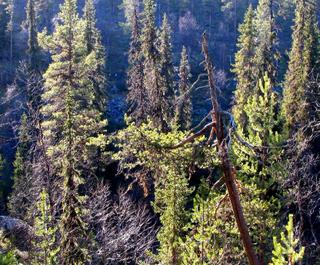 Tervasrosoinen (Cronartium flaccidum) mänty Kynsivaaran länsirinteellä; lokakuun aurinko yltää juuri kuruun.
Tervasrosoinen (Cronartium flaccidum) mänty Kynsivaaran länsirinteellä; lokakuun aurinko yltää juuri kuruun.Resin top of pine (Cronatium flacidum) in Kynsivaara hill, on the western slope. Low shining October sun just reaches the creek.
Thursday, October 13, 2005
Kynsivaaran kynsi - Fingertip of Kynsivaara hill
 Kynsivaaran kynsi, taustalla Nuorttitunturi
Kynsivaaran kynsi, taustalla NuorttitunturiFingertip of Kynsivaara hill, Nuorttitunturi (Nuortti fell) at background
Wednesday, October 12, 2005
Kuusivanhus kumossa - Old Norway spruce fell down
 Syysmyrskyt kaatavat Värriön luonnonpuiston vanhoja, tyveltään jo lahonneita kuusia. Tämän kuusen myrsky riuhtaisi juuriltaan Värriö I:n länsipuolella.
Syysmyrskyt kaatavat Värriön luonnonpuiston vanhoja, tyveltään jo lahonneita kuusia. Tämän kuusen myrsky riuhtaisi juuriltaan Värriö I:n länsipuolella.Autumn storms are falling down old, already rotten Norway spruces. This oldie was teared down from its roots on the western side of Varrio I.
Tuesday, October 11, 2005
Myöhäinen punakylkirastas - Late Redwing
Myöhäinen punakylkirastas (Turdus iliacus) vihelteli klo 10:45 Kotovaarassa, Nuorttitunturin puoleisella rinteellä. Kyseessä oli muutaman yksilön parvi, joka lienee ollut muuttomatkalla länteen päin.
Late Redwing (Turdus iliacus) whistled at 10:45 AM in Kotovaara, on the northern side, towards the Nuortti fell. It was part of a small flock that seemed to be on migration towards west.
Late Redwing (Turdus iliacus) whistled at 10:45 AM in Kotovaara, on the northern side, towards the Nuortti fell. It was part of a small flock that seemed to be on migration towards west.
Monday, October 10, 2005
SMEAR-aseman syyshuoltoa - The autumn routines of SMEAR-station
Kolmen päivän aikana olemme purkaneet SMEAR-aseman fotosynteesimittaukset ja tehneet jokasyksyisen huollon. Ympäri vuoden asemalla mitataan aerosoleja, typen ja rikin oksideja, otsonia ja sulfaatteja. Säätornista mitataan auringosta tulevaa säteilyä (kokonaissäteilyä, fotosynteettisesti aktiivisia aallonpituuksia, UVA- ja UVB-säteilyä), tuulen nopeutta (5 eri tasolta kuppianemometreillä ja 16:n metrin korkeudesta tuulen horisontaalikomponentteja) ja suuntaa, kostea- ja kuivalämpötilaa ja näistä laskettua suhteellista kosteutta, maanpinnan lämpötilaa sekä sademäärää. Huoltotiimiin kuuluivat Toivo Pohja, Pasi Aalto, Roope Kivekäs, Ella-Maria Kyrö ja Petteri Mönkkönen. (E-MK ja PM)
The last 3 days we have undeployed the photosynthesis measurements of SMEAR-station and done other autumn routines. Around the year the station is measuring aeorosols, nitric and sulphur oxides, ozone and sulphids. The weather station is measuring solar radiation (global radiation, photosynthetically active radiation, UVA- and UVB-radiation), wind speed (at 5 different levels with cup anemometers and the horisontal components from 16 meters) and direction, wet and dry temperature and from these parameters calculated relative humidity, ground temperature and precipitation. Mr. Toivo Pohja, Mr. Pasi Aalto, Mr. Roope Kivekäs, Ms. Ella-Maria Kyrö and Mr. Petteri Mönkkönen participated the maintainance team. (E-MK and PM)
The last 3 days we have undeployed the photosynthesis measurements of SMEAR-station and done other autumn routines. Around the year the station is measuring aeorosols, nitric and sulphur oxides, ozone and sulphids. The weather station is measuring solar radiation (global radiation, photosynthetically active radiation, UVA- and UVB-radiation), wind speed (at 5 different levels with cup anemometers and the horisontal components from 16 meters) and direction, wet and dry temperature and from these parameters calculated relative humidity, ground temperature and precipitation. Mr. Toivo Pohja, Mr. Pasi Aalto, Mr. Roope Kivekäs, Ms. Ella-Maria Kyrö and Mr. Petteri Mönkkönen participated the maintainance team. (E-MK and PM)
Sunday, October 09, 2005
Hirvas- ja Kuntasjoki syysasussa - Hirvas and Kuntas river in late autumn
 Värriön luonnonpuistoa halkoo lännestä itään kaksi kirkasta jokea: Kuutsjärvestä alkunsa saava Kuntasjoki ja Syväkurusta lähtevä Hirvasjoki. Ne yhtyvät toisiinsa juuri ennen Venäjän rajaa. Joki jatkaa Hirvasjokena Venäjän puolelle ja yhtyy sittemmin Jäämereen laskevaan Nuorttijoen vesistöön. Kuvassa oikealla Kuntasjoki ja vasemmalla Hirvasjoki.
Värriön luonnonpuistoa halkoo lännestä itään kaksi kirkasta jokea: Kuutsjärvestä alkunsa saava Kuntasjoki ja Syväkurusta lähtevä Hirvasjoki. Ne yhtyvät toisiinsa juuri ennen Venäjän rajaa. Joki jatkaa Hirvasjokena Venäjän puolelle ja yhtyy sittemmin Jäämereen laskevaan Nuorttijoen vesistöön. Kuvassa oikealla Kuntasjoki ja vasemmalla Hirvasjoki.Two small rivers with crystal clear waters, both flowing from west to eastwards, have their origin in Varrio nature reserve. Kuntas river has its source in Kuuts lake whereas Hirvas river flows from Deep Creek. The rivers join in one bigger river, with name Hirvas river just before the flow passes the Finnish - Russian border. The river joins Nuortti river in Russia which finally has its outlet in Tuuloma, at the Arctic Sea.
Saturday, October 08, 2005
Lakastunutta ruskaa - withering colors
 Tunturin ruskantekijöistä loistavin, karmiininpunaisena aikaisemmin hohtanut riekonmarja (Arctostaphylos alpinus) on menettänyt värinsä. Lakastuvat lehdet odottavat lunta mustanpuhuvan punaruskeina.
Tunturin ruskantekijöistä loistavin, karmiininpunaisena aikaisemmin hohtanut riekonmarja (Arctostaphylos alpinus) on menettänyt värinsä. Lakastuvat lehdet odottavat lunta mustanpuhuvan punaruskeina.The most flamboyant autumn plant in the fells, carmine red Alpine bearberry (Arctostaphylos alpinus), has lost her glamour. Just before the snow the withering leaves have turned into darkish - brownish - red.
Friday, October 07, 2005
Taviokuurnat muuttavat, myöhäinen peippo - Pine grosbeaks en route, a late Chaffinch
Taviokuurnat (Pinicola enucleator) muuttavat parhaillaan Värriön tutkimusaseman yli. Kotovaaran laidasta kuuluu aamuisin heleä ti-lu-lii viserrys. Muuttosuunta Värriötunturissa on idästä länteen.
Tutkimusaseman pihalla pyörähti pikkukäpylintujen (Loxia curvirostrata) sekaparvi, jossa joukossa oli myöhäinen urospeippo (Frincilla coelebs). Myöhäiseen, lämpimään syksyyn sopii myös myöhäinen peippohavainto.
Pine grosbeaks (Pinicola enucleator) are migrating over the Varrio research station. Joyful sound ("ti-lu-lii" - Finnish imitation) is often heard from souther slopw of Kotovaar hill. Their migration direction over the Varrio fells is from east to west.
A mixed flock of Common crossbills (Loxia curvirostra) was seen in front of Varrio research station. A late Chaffinch (Frincilla coelebs), male, was seen (TH) in the flock. Late, abnormally warm autumn seems to keep some the migratory birds still in Lapland.
Tutkimusaseman pihalla pyörähti pikkukäpylintujen (Loxia curvirostrata) sekaparvi, jossa joukossa oli myöhäinen urospeippo (Frincilla coelebs). Myöhäiseen, lämpimään syksyyn sopii myös myöhäinen peippohavainto.
Pine grosbeaks (Pinicola enucleator) are migrating over the Varrio research station. Joyful sound ("ti-lu-lii" - Finnish imitation) is often heard from souther slopw of Kotovaar hill. Their migration direction over the Varrio fells is from east to west.
A mixed flock of Common crossbills (Loxia curvirostra) was seen in front of Varrio research station. A late Chaffinch (Frincilla coelebs), male, was seen (TH) in the flock. Late, abnormally warm autumn seems to keep some the migratory birds still in Lapland.
Thursday, October 06, 2005
Maaruskasta vain rippeet jäljellä - Autumn colors have gone
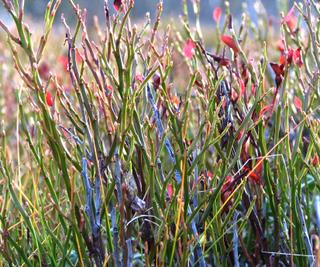 Jos Värriön maaruska oli täydessä loistossaan syyskuun lopussa (ks. luontopäiväkirja 30.9.2005), viikkoa myöhemmin siitä on vain rippeet jäljellä. Väliin mahtuu vesisade ja kova tuuli, ei sen sijaan varsinaista hallaa. Mustikan kaljut varret ovat valmiit talveen ja lumeen.
Jos Värriön maaruska oli täydessä loistossaan syyskuun lopussa (ks. luontopäiväkirja 30.9.2005), viikkoa myöhemmin siitä on vain rippeet jäljellä. Väliin mahtuu vesisade ja kova tuuli, ei sen sijaan varsinaista hallaa. Mustikan kaljut varret ovat valmiit talveen ja lumeen.If the the Varrio autumn colours were in their full splendor (see the Nature Diary note of 30.9.2005), just one week later the colors have gone. In between, there was rain and strong wind but no real ground frost. The bare stalks of bilberry (Vaccinium myrtillus) are ready for winter and snow.
Wednesday, October 05, 2005
Metsälauhaa Pultoseljässä - Wavy hairgrass in Pultoselka
 Värriön tulotie ylittää Lattunan ja Tulppion välissä laajan Pultoseljän. Se on talousmetsäaluetta, jonka hakkuualueet hohtavat lokakuun alussa keltaisenaan metsälauhaa (Deschampsia flexuosa). Metsälauha on poron tärkeimpiä laidunkasveja.
Värriön tulotie ylittää Lattunan ja Tulppion välissä laajan Pultoseljän. Se on talousmetsäaluetta, jonka hakkuualueet hohtavat lokakuun alussa keltaisenaan metsälauhaa (Deschampsia flexuosa). Metsälauha on poron tärkeimpiä laidunkasveja.The road to Varrio passes between Lattuna an Tulppio a large hill called Pultoselka. It is under normal forestry activities. In the begunning of October the clearcutting areas shine as yellow. This is due to Wavy hairgrass (Deschampsia flexuosa). It belongs to the important fodder plants for reindeers.
Tuesday, October 04, 2005
Jäkkiä Rakitsan jängällä - Matgrass on Rakitsa mire
 Rakitsan kuivahkolla, ohutturpeisella jängällä, Värriö ykkösen ja Rakitsanvaaran välissä kasvaa kasvaa mattomaisena matalaa heinää, jäkkiä (Nardus stricta). Ruskan myötä se kuloontuu.
Rakitsan kuivahkolla, ohutturpeisella jängällä, Värriö ykkösen ja Rakitsanvaaran välissä kasvaa kasvaa mattomaisena matalaa heinää, jäkkiä (Nardus stricta). Ruskan myötä se kuloontuu.In the dry, thin peatbog of Rakitsa mire a low, matlike Nardus stricta - the Matgrass is found. In the late autumn it has changed its color into pale brown.
Monday, October 03, 2005
Järripeipon pesä ruskassa - Nest of Brambling in autumn colors
 Järripeippo (Fringilla montifringilla) on Värriön tunturikoivuvyöhykkeen yleisin kesälintu. Se pesii koivussa, mutta koivun ollessa lehdessä pesiä on vaikea havaita. Sen sijaan jo lehdettömäksi jääneestä koivusta edelliskesän pesä näkyy hyvin, maaruskaa vasten.
Järripeippo (Fringilla montifringilla) on Värriön tunturikoivuvyöhykkeen yleisin kesälintu. Se pesii koivussa, mutta koivun ollessa lehdessä pesiä on vaikea havaita. Sen sijaan jo lehdettömäksi jääneestä koivusta edelliskesän pesä näkyy hyvin, maaruskaa vasten.In birch dominated regio subalpina of the Varrio fells, Brambling (Fringilla montifringilla) is the most common bird species in summer. Its nest is in birch, but while the birch is in full summer leaf the nest is not that easy to find. After the leaves have fallen from the tree, the nest of the previous summer is well seen, against the autumn colors in the ground.
Sunday, October 02, 2005
Kukkiko Lapissa kaikki nopeammin: suopursu - Did Labrador-tea flower earlier?
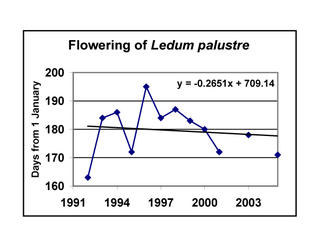
Suopursun (Rhododendron tomentosum, aikaisempi synonyymi Ledum palustre) kukinta alkaa Värriössä kesä-heinäkuun vaihteessa. Kukinnan alku on aikaistunut vuodesta 1992 lähtien neljällä päivällä. Vuoden 2006 ennusteen mukaan kukinnan alkupäivä on 27. kesäkuuta.
The onset of flowering of Labrador-tea (Rhododendron tomentosum, earlier synonym Ledum palustre) in Varrio is at the end of June. The onset takes place now on average four days earlied than in the beginning of 1990s. The predicted date for 2006 is 27. June.
Saturday, October 01, 2005
Varpushaukkoja ja pyrstötiaisia - Eurasian sparrow hawks and Long-tailed tits
Tullessani töihin havaitsin 2 varpushaukan (Accipiter nisus) kisailevan Rovalan kohdalla noin klo 10. Kauempana oli ilmeisesti kolmas. Lähistöllä oli myös närhi (Garrulus glandarius).
Tutkimusasemalla näin parven pyrstötiaisia (Aegithalos caudatus). Siinä oli noin 6 yksilöä. Parvi kiirehti aseman länsipuolitse pohjoiseen klo 15.30. Tämä oli 2. havainto Värriön luonnonpuistosta aseman historian aikana. TH
When I was coming to work I saw 2 Eurasian sparrow hawks (Accipiter nisus) flying above the village of Rovala at 10 o´clock. There was also third hawk of the same size, obviously of the same species. Near these there was also one Eurasian Jay (Garrulus glandarius).
At the Varrio station there was a group (about 6 birds) of Long-tailed Tits (Aegithalos caudatus). The group was hurrying to the north at 15.30 on the west side of the station. This was the 2. observation of Long-tailed tit in the history of Varrio station. TH
Tutkimusasemalla näin parven pyrstötiaisia (Aegithalos caudatus). Siinä oli noin 6 yksilöä. Parvi kiirehti aseman länsipuolitse pohjoiseen klo 15.30. Tämä oli 2. havainto Värriön luonnonpuistosta aseman historian aikana. TH
When I was coming to work I saw 2 Eurasian sparrow hawks (Accipiter nisus) flying above the village of Rovala at 10 o´clock. There was also third hawk of the same size, obviously of the same species. Near these there was also one Eurasian Jay (Garrulus glandarius).
At the Varrio station there was a group (about 6 birds) of Long-tailed Tits (Aegithalos caudatus). The group was hurrying to the north at 15.30 on the west side of the station. This was the 2. observation of Long-tailed tit in the history of Varrio station. TH
Labels: närhi, pyrstötiainen, varpushaukka